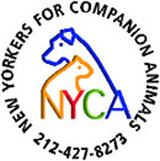New Yorkers for Companion Animals

| 
|
On a steamy St. Louis day in August, workers at Petropolis Pet Center found an odd delivery hitched to the store's lamppost. A scrap of twine around the visitor's neck had etched a ring of pink skin. His tail wagged cautiously as if caught between instinct and fear.
Beneath a lopsided grin, broken teeth conveyed the dog's lost battle with the rope. Eyes too large for the gaunt face retold a thousand days of loneliness and despair. He was a shadow of the dog he might have become, skeletal and shamefully bald due to advanced sarcoptic mange.
But the people who found him saw a gentle soul behind the frayed exterior. With medical treatment and hands-on love, he became M & M (Emmie to friends), a vibrant three- to four-year old white German Shepherd eager to plant sloppy kisses.
"Despite severe neglect at the hands of humans, M & M loves people," says Harriet J. Cuddy, a Pet Loss and Bereavement Counselor and Director of Admissions for the Academy of Grooming at Petropolis. By the time he left with All Paws Rescue, Inc., a non-profit that fosters and adopts rescued animals, M & M was an ambassador for all dogs whose lives begin and end on a chain.
Some aren't as fortunate as M & M. The Humane Society of the United States (HSUS) describes one tethered dog whose collar, an electrical cord, grew so embedded in his neck the plug was no longer visible. A veterinarian could not remove the device and had to euthanize the dog.
In Stillwater, Oklahoma, Thomas Louis Verner was charged with animal cruelty for tying his bulldog Notorious to a tree for a full year. Notorious eventually escaped to neighbor Kelly Vierling's doorstep. Shredded rope still dangled from his neck and he emitted a horrible stench. Vierling uncovered an oozing neck wound where two tightly bound ropes had grown into the dehydrated dog's skin. Veterinarian Monica Bentley later described the maggot-infested wound as "rotting tissue. There were only two inches of his neck where his skin was not broken."
While Verner faces a five-year prison term, dogs affixed to immovable objects face perpetual boredom and exile. "As the days become years, these dogs sit, stay, defecate and, if among the fortunate, eat within a 10-foot radius," claims Tammy S. Grimes, founder of Dogs Deserve Better, a non-profit group dedicated to bringing "best friends" into the home and family.
For six years Grimes drove past a little dog named Bo (formerly Worthless) chained to a post near her home. "I stared obsessively out my car window...[watching] him suffer the solitude of a lonely, tribeless existence. When my intuition told me he was ill, I could bear it no longer." Bo's eventual rescue inspired Grimes to rally communities nationwide to ban inhumane tethering.
Towns in Arkansas, Arizona and North Carolina prohibit tethering as a form of constant confinement. Other communities regulate the number of hours a dog may be chained. The U.S. Department of Agriculture concludes "continuous confinement of dogs by tether is inhumane. A tether can become tangled around or hooked on the dog's shelter structure or other objects, further restricting the dog's movement and potentially causing injury."
Guardians who chain dogs are less inclined to clean living areas, leaving animals to eat, sleep, urinate and defecate over the same rundown ground. As he tugs and strains against his collar, a restrained dog's neck deteriorates into a band of welts and abrasions. He endures infrequent meals, capsized water bowls, insufficient veterinary care and exposure to weather extremes.
Yet for dogs the cruelest component to life on a chain is psychological. They identify human caretakers as members of the pack. Of the hundreds of thousands of dogs who live with people, at least 25% are tethered as a primary mode of shelter. Most are un-neutered males who survive defensively without an essential connection to humans or other animals.
After months or even years of isolation, "an otherwise friendly and docile dog becomes neurotic, unhappy, anxious, and often aggressive," the HSUS notes. A study published in the Journal of the American Veterinary Medical Association (9/15/00) linked 17% of fatal dog attacks from 1979 to 1998 with dogs restricted on their guardian's property. A leashed dog may lash out at any strange person or animal who invades his sparse domain. If un-neutered, he is statistically more prone to bite or fight. Most victims are children, aged 12 and under, who do not understand the dog's heightened territorial instinct. Cats, rabbits and other small animals are also at risk.
Proper nutrition, exercise, spay/neuter and veterinary care are a caregiver's basic tasks. Beyond maintenance, all companion animals need friendly words and a familiar touch. An animal's unique personality brings laughter and love to the daily heartbeat of a home. An endlessly chained or penned dog lives as captive, not companion, through snow, ice, rain and heat. He deserves what he covets most--a place within his family.
WHAT YOU CAN DO
1.) If you are worried about a dog restrained outdoors without adequate food, water or shelter, contact the local animal control agency or humane society to inquire about anti-cruelty laws. An officer or cruelty investigator may prompt the guardian to rectify the situation. If the animal is to be confiscated, make arrangements for foster care. An abused dog who enters a "kill shelter" may be labeled unadoptable without a reasonable period of rehabilitation.
2.) If you feel awkward confronting a negligent caretaker, ask Dogs Deserve Better, Inc. to anonymously mail information to the caretaker's home.
Contact:
Tammy S. Grimes, Dogs Deserve Better, Inc.
PO Box 23
Tipton, PA 16684
toll free: 877-636-1408
3.) To learn how you can mobilize your community to enact a dog-tethering ban and enforce existing animal protection laws, contact:
The HSUS
2100 L Street NW
Washington, DC 20037
202-452-1100